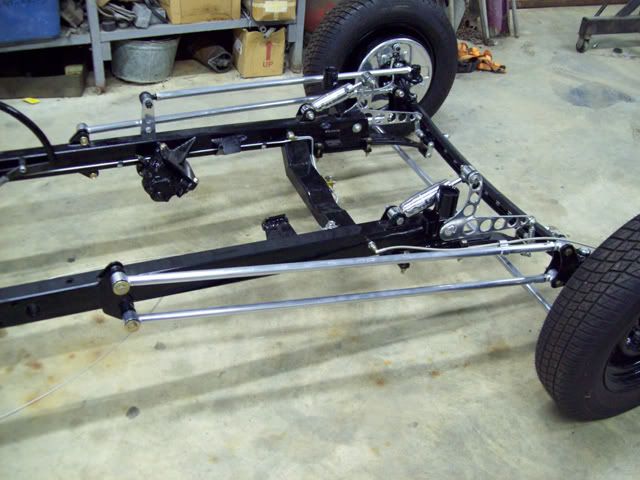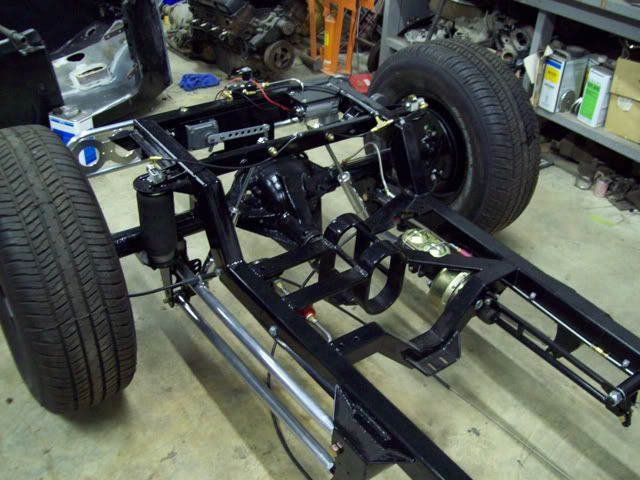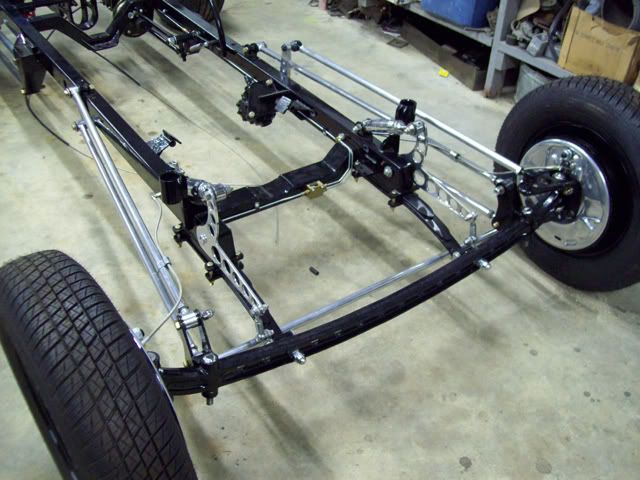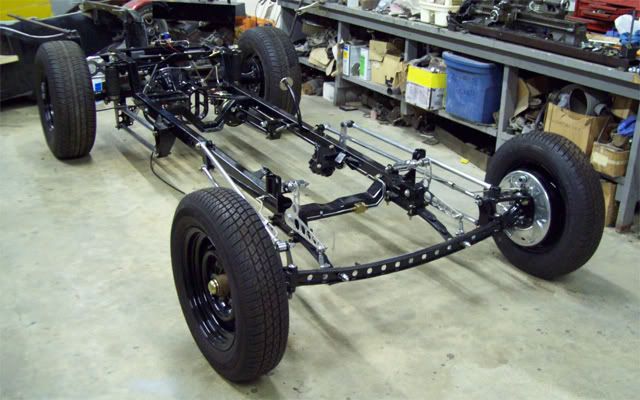Threaded View
-
12-28-2008 06:04 PM #11
 It's going back together!!
It's going back together!!
Now that Christmas is over, I thought I would take time to post an update. I hope everyone had a good holiday.
First things first, though. I have to make a correction to an earlier post.
Turns out that my math was off in my post about the wheel cylinders. The 1Ē and 15/16Ē combo Iím using actually gives me a 12% difference instead of the 19% figure that I posted.
The 1 1/8Ē and 1Ē combo would actually be 21% difference.
I had refigured everything for my post and donít even know where I got those numbers. Must have left my brain somewhere else that day!

Sorry if I caused anyone to be confused.
The frame front and rear suspensions have been assembled and squared. I still need to set the pinion angle and the caster on the front end. Iím waiting until the engine is in for this step. I can go over all the bolts then and make sure they are tightened and locked.
The air compressor, valves and air bags are all mounted and plumbed. The valves are small 1/8Ē stainless steel units, but they're big enough for what I'll be using them for. I mounted a valve directly to each bag using solid pipe fittings to keep the two sides of the car separate. Each bag will be a separate "spring", so there shouldn't be any air transfer from bag to bag when the car leans. Should also help keep any small leaks at the tubing connections from bleeding the bags down overnight since they're essentially sealed. It has been aired up for about 2 weeks now and doesnít appear to have leaked down.
When I was testing this setup earlier in the build, it only took about 30-40 lbs. of air to hold the car at ride height with one person on board. I would be surprised if it took more than 50-60 when it was fully loaded. Each bag has an 800 lb rating at 100 PSI. There is one valve with a restrictor mounted on an aluminum manifold to bleed off air, so only 3 valves are needed for the whole system. There is no air tank; the air compressor will push air directly into the bags. During earlier testing, the compressor took only a few seconds fill the bags if they were empty. There is a safety switch on the distribution manifold that will kill the compressor if the system gets to 105 PSI.
Iím using a GM control switch to keep the ride height where I want it. These were used on high end GM cars in the 70ís through the 90ís. They are not much bigger than a pack of cigarettes and attach to the frame. An arm and linkage attaches to the rearend. The length of the link determines the ride height. Not as sophisticated as the programmable controllers on the market today, but theyíre usually cheap and as close as your local junk yard. Add a couple of automotive relays and youíre good to go.
Hard to see in the pics, but I rounded the ends of the leaf springs to make them look a little better. I also added a third leaf to the front spring packs. I didnít feel real confident about using just two leafs. These are heavier ľĒ thick leafs.
I spent a lot of time chasing threads and fitting parts where they were powder coated. Note to self: Donít build this stuff so tight if youíre going to powder coat it! The ceramic coating is aluminum based, so I used liberal amounts of anti-seize compound. I didnít want to risk galling the threads.
The brakes are bled, but not without some problems. I had a new wheel cylinder leaking!! No, it wasnít one of the modified cylinders. It was one of the new ones I bought for the front. I pulled it apart and found that it was full of crap that looked like kitty litter. Nothing was damaged, but the crud had gotten under the cup lips and wasnít allowing it to seal. After cleaning it up everything was fine, but I use a pressure bleeder and it sure made a heck of a mess before I saw it was leaking. I hate to think that Iím going to have to start pulling NEW parts down and check them before I use them. More of that good Chinese crap!
Nothing was damaged, but the crud had gotten under the cup lips and wasnít allowing it to seal. After cleaning it up everything was fine, but I use a pressure bleeder and it sure made a heck of a mess before I saw it was leaking. I hate to think that Iím going to have to start pulling NEW parts down and check them before I use them. More of that good Chinese crap!
All of the hard fuel lines, the fuel pump and filter are installed. I still have to make up the braided flex lines for the fuel system.
The engine and trans is going in tomorrow.










 4Likes
4Likes LinkBack URL
LinkBack URL About LinkBacks
About LinkBacks
 Reply With Quote
Reply With Quote

I saw last night on fb about John. The world sure lost a great one. I'm going to miss his humor, advice, and perspective from another portion of the world. Rest in Peace Johnboy.
John Norton aka johnboy